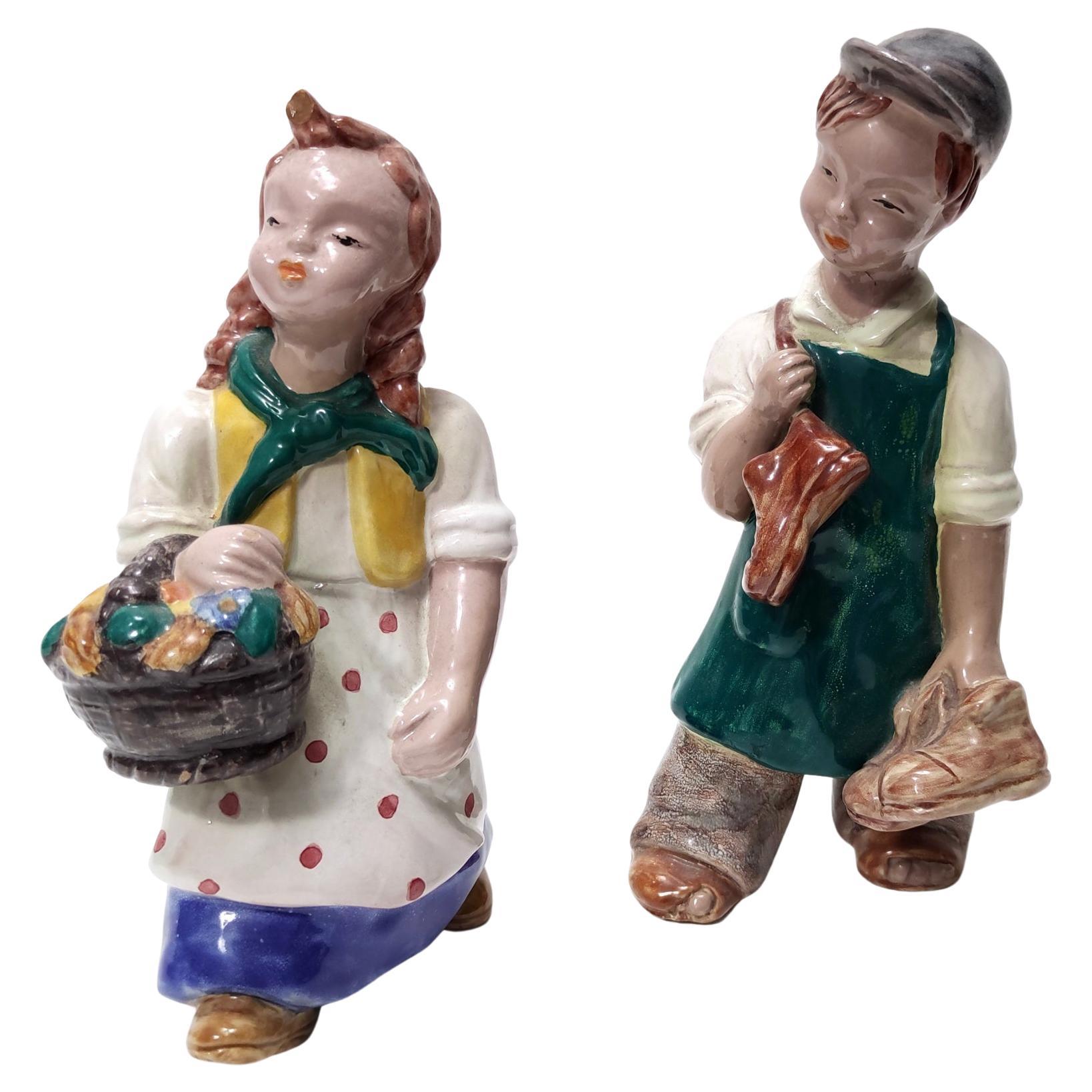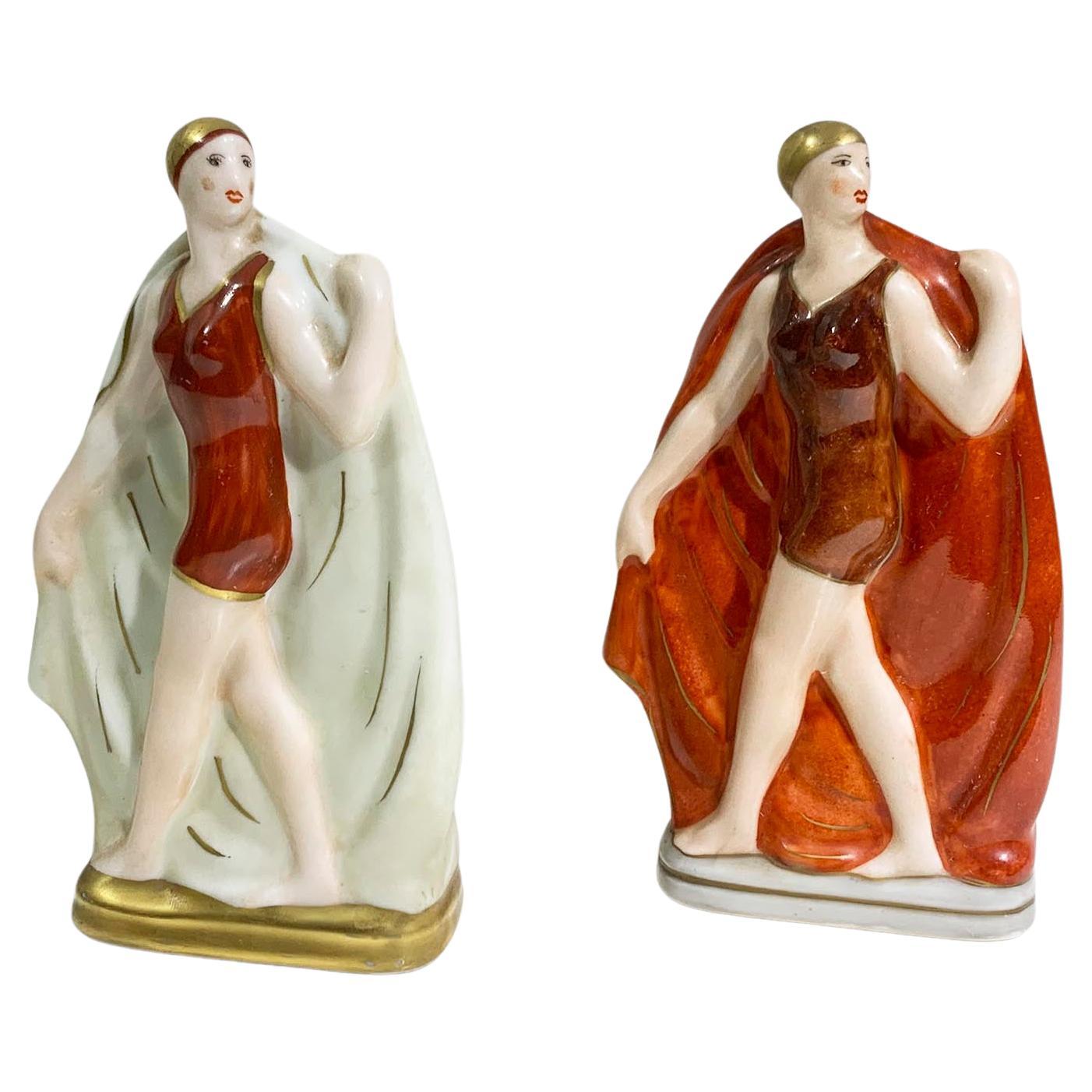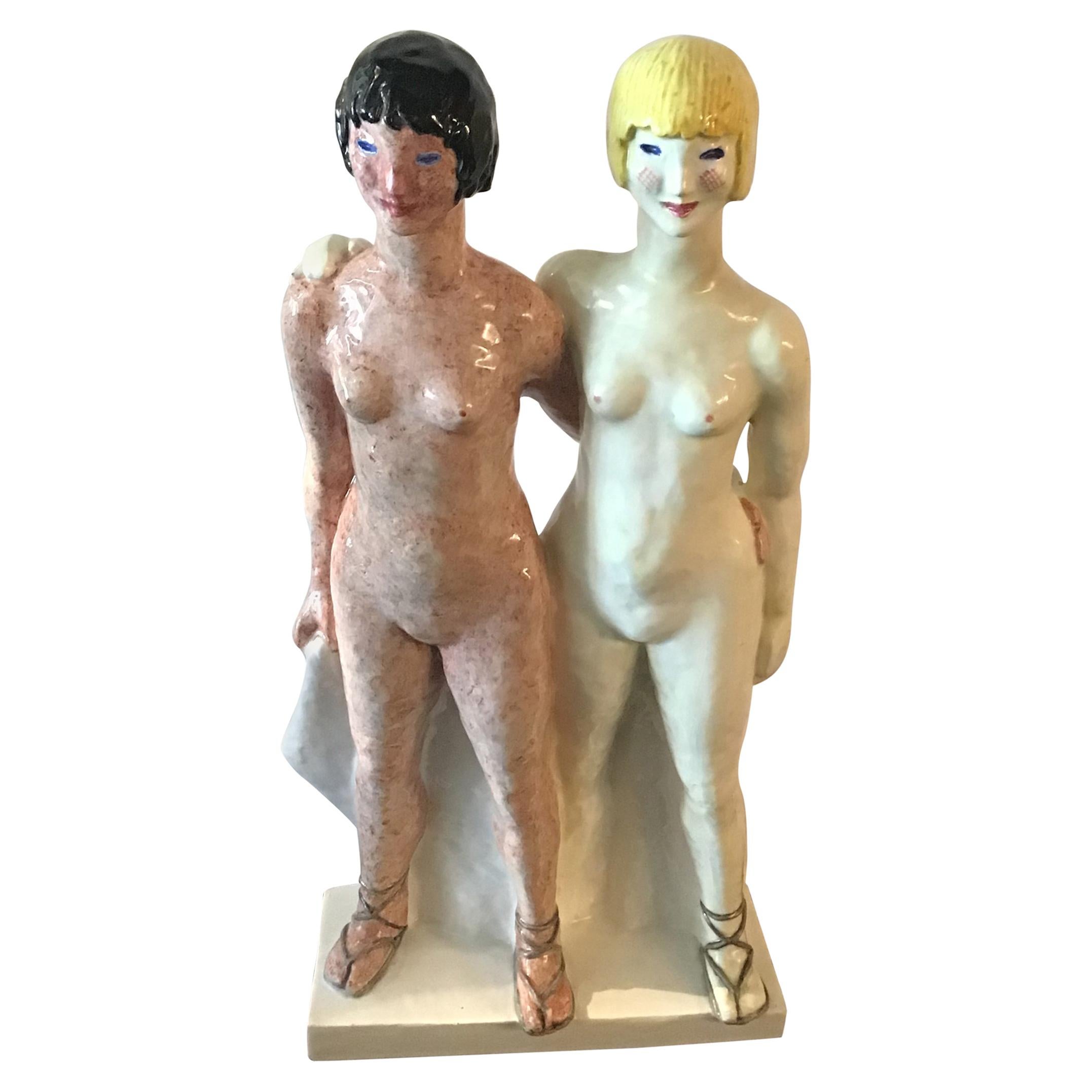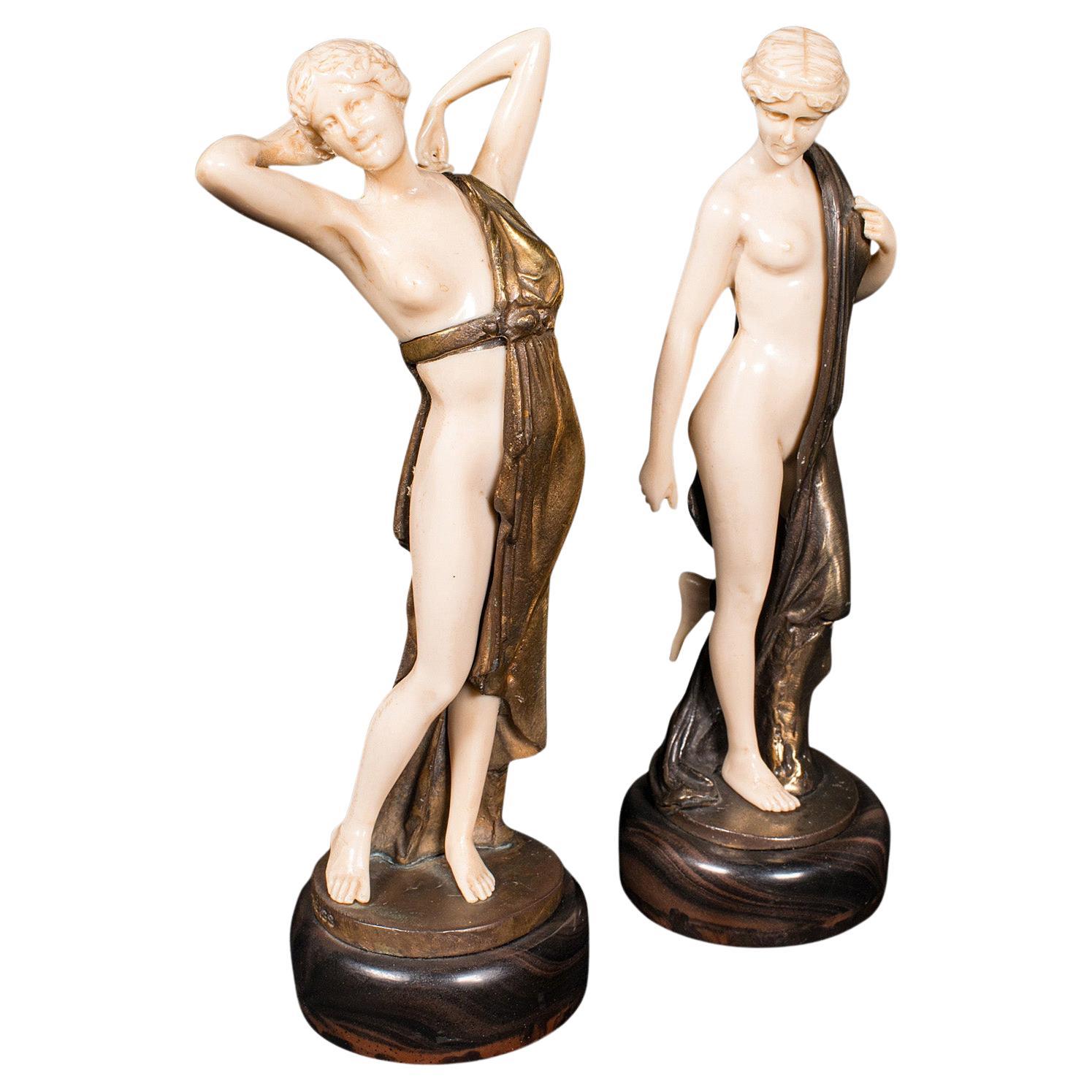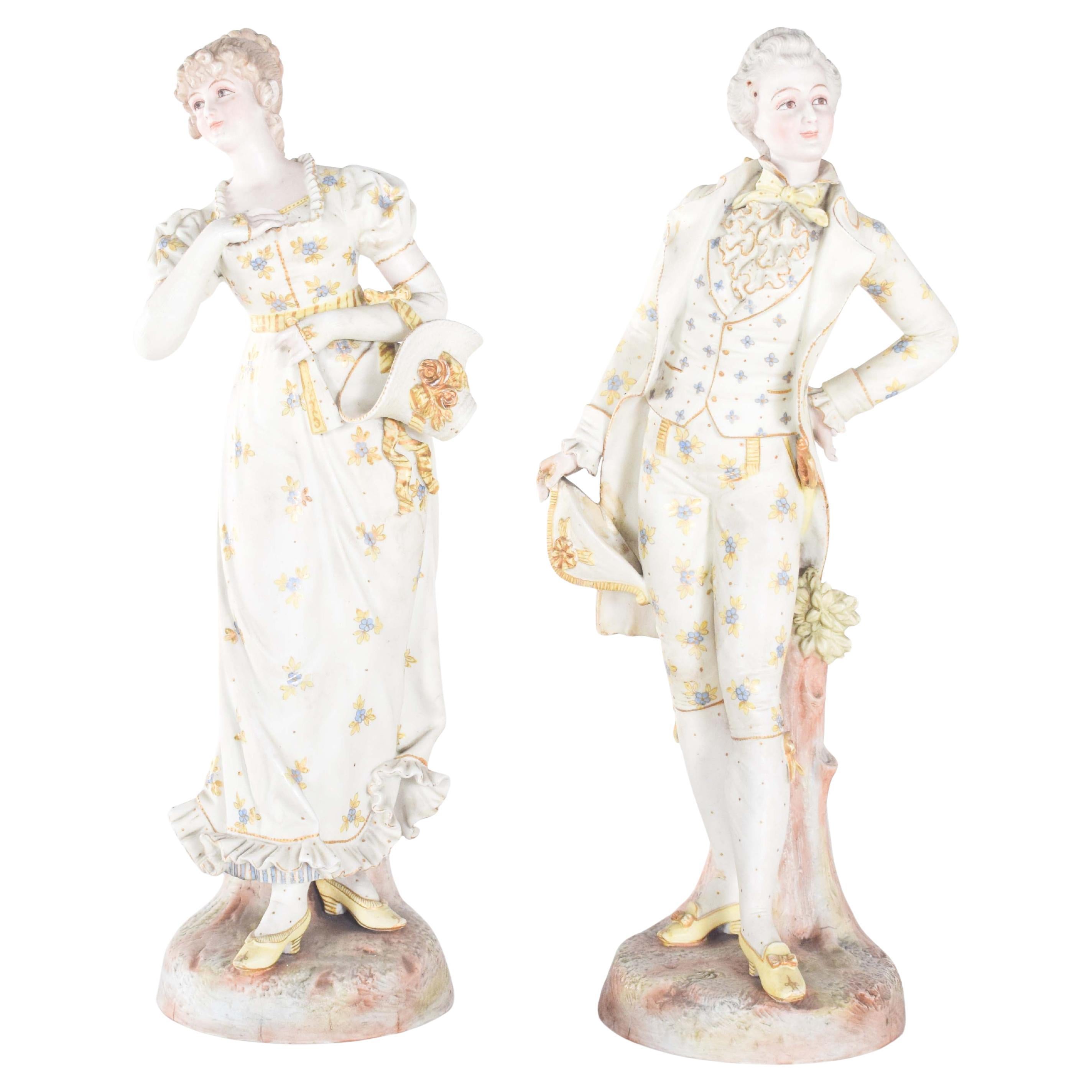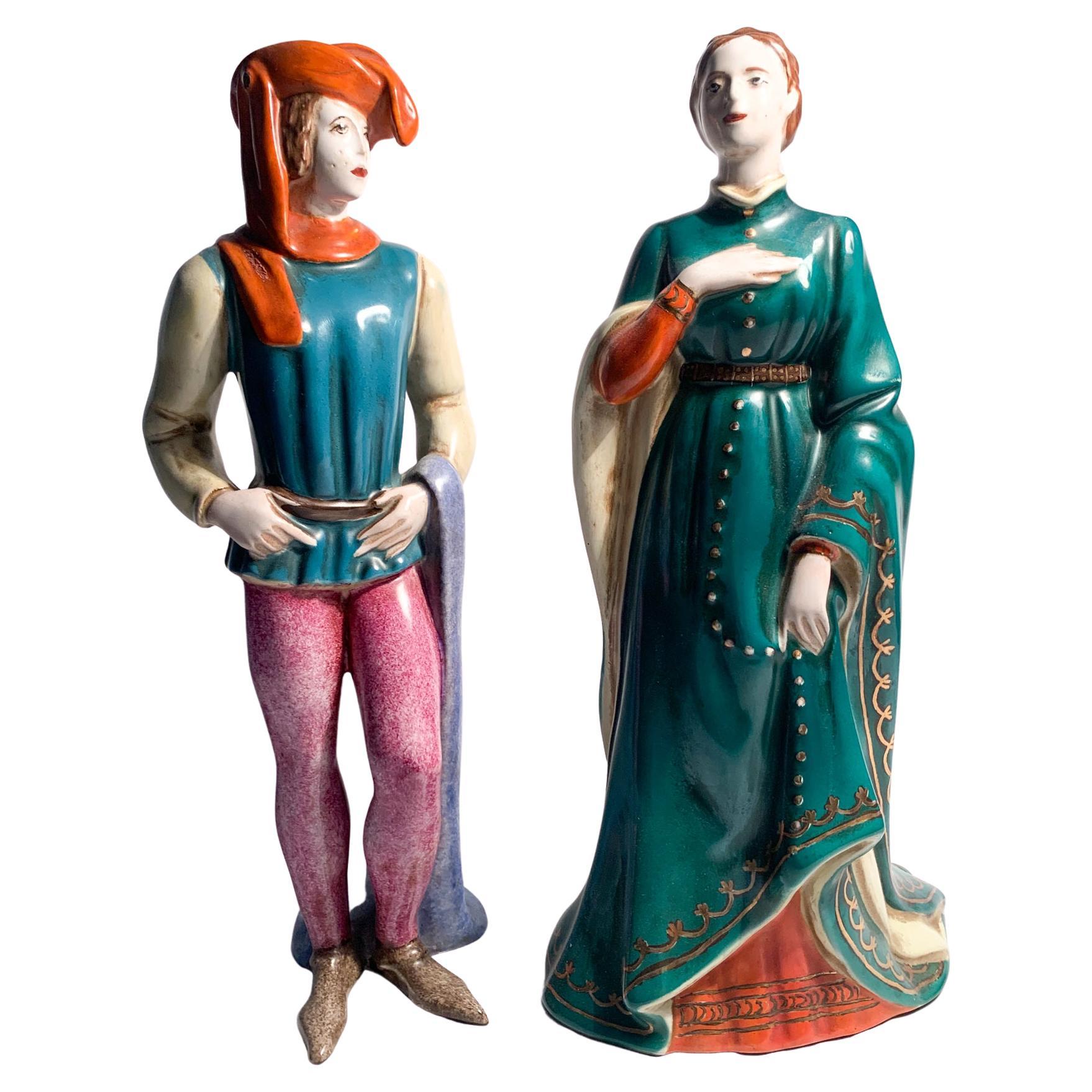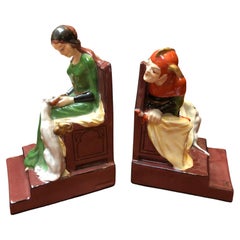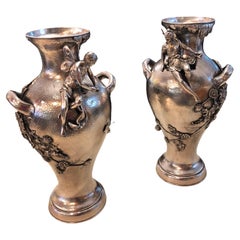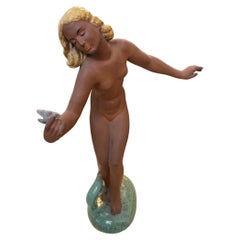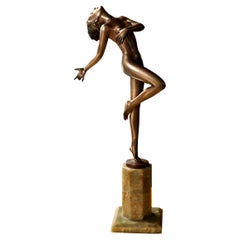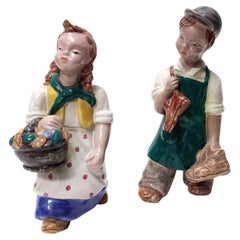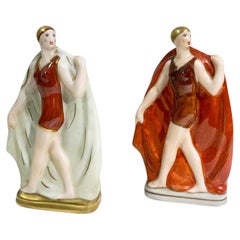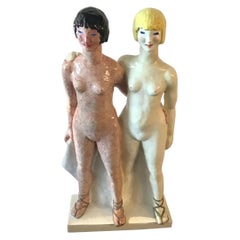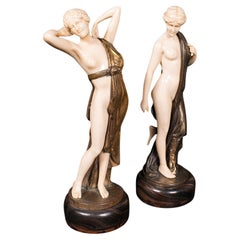Items Similar to Pair of Ceramics, Boch.F, Sign: Catherine Barjansky, Belgium
Video Loading
Want more images or videos?
Request additional images or videos from the seller
1 of 22
Pair of Ceramics, Boch.F, Sign: Catherine Barjansky, Belgium
$28,000
£21,157.93
€24,488.51
CA$39,282.62
A$43,693.54
CHF 22,921.57
MX$533,160.51
NOK 287,694.68
SEK 271,117.34
DKK 182,796.40
About the Item
Pair of ceramics
Sign:
Ceramic with enamel : Catherine Barjansky
Made in Belgica Boch
Ceramic White:
Sign: BFK made in Belgium
The Boch manufacture was established in Belgian La Louvière by Jean-François Boch, one of main owners of another known company, Villeroy & Boch. The direction of Boch Freres SNC was in 1844 taken by Victor Boch. Production could be started immediately thanks to other Boch family ceramic businesses that sold Victor ready-to-use copperplates.
This faience manufacture developed very fast. In 1847 the company won a gold medal at the exhibition of the Belgian industry. In 1855 they already employeed 300 workers in La Louvière (Keramis) and 100 in Tournai (Boch Freres) factory. Around 1860 the production of polychrome pieces was started. In 1904 the first in Europe tunnel kiln was launched.
Problems started in 1970s. The company went bankrupt in 1985 and was reactivated as Novoboch and MRL Boch. In 2015 was started Keramis Center, just two rooms showing Royal Boch history.
One of the most important designers for Boch Frères Keramis was Charles Catteau. He was French but in 1906 moved to La Louvière. Patterns designed by Catteau were created in following years:
The Boch Frères Kéramis factory (Belgium, province of Hainaut, La Louvière) is now well known thanks to the work of the very dynamic Charles Catteau. That of the sculptor Catherine Barjansky is much less so, even if her career is international: Rome, Berlin, New York, Vienna, Paris, Brussels...
Catherine is from Odessa, a Ukrainian city located in the Soviet Empire. At the age of twenty, she studied sculpture in Monaco where she met her husband, Alexandre Barjansky, the famous violinist whose name is now inseparable from a Stradivarius! Thanks to her husband's job, she travels a lot.
Witnesses to his exchanges with the intellectual milieu of the time, his portraits of personalities dominate his work: a bust of Einstein, kept at the Solvay Institute in Brussels; a bust of Freud; or even Colette, author who prefaced her first exhibition in Brussels. She made a bust of Queen Elisabeth of Belgium, to whom she is close. Catherine Barjansky loved making “miniatures” and it was in a suitcase that she brought seventy of her works to Brussels for the first time to exhibit them there.
This art of sculpture - her passion - she exercised it throughout her life. She taught it in Rome where she founded a school in 1918, but also in Brussels in the 1920s and 30s and in New York after 1939.
Contacts with Charles Catteau and the Boch (BFK) company, located barely seventy kilometers from the capital, began around 1935. Hainaut coal was then a hotbed of creativity and a significant concentration of skills in fields of fire arts. Belgian Art Deco ceramics were living their hours of glory.
We have specialized in the sale of Art Deco and Art Nouveau and Vintage styles since 1982. If you have any questions we are at your disposal.
Pushing the button that reads 'View All From Seller'. And you can see more objects to the style for sale.
Why are there so many antiques in Argentina?
In the 1880 – 1940 there was a grate wave of immigration encouraged by the periods of war that were taking place.
1st World War took place between 1914 and 1918
2nd World War took place between 1939 and 1945
The immigrants options were New York or Buenos Aires. Tickets were cheap and in Buenos Aires they were welcomed with open arms, as it was a country where everything was still to be done.
Argentina was the country of new opportunities, labour was needed and religious freedom was assured, in many cases the of the family travel first until they were settled and then the rest of the family members join them.
In the immigrant museum “Ellis Island Immigrant Building” in New York you can se the promotional posters of the boats that would take them to a new life.
Between the years 1895 and 1896, Argentina had the highest DGP (gross domestic product) per capita in the world according to the Maddison Historical Statistics index, this situation arose due to the large amount of food being exported to European countries, which were at war.
The Argentinean ships left the port of Buenos Aires with food, but they returned with furniture, clothes and construction elements, (it´s common to see this the old buildings of the historic neighbourhood of San Telmo, the beams with the inscription “Made in England)”, as well as many markets that were built in Buenos Aires, such us the San Telmo Market, whose structure was brought by ship and afterwards assembled in 900 Defensa Street.
With the great influence of European immigrants living in the country, the children of the upper classes travelled to study in France, resulting in the inauguration of “La Maison Argentinienne”, on 27th of June 1928, in the international city of Paris, which hosted many Argentinians that were studying in Frace.
It´s the fourth house to be built after France, Canada and Belgium, being the first Spanish-speaking one. Still in place today (17 Bd Jourdan, 75014, Paris, France). Many of the children of these wealthy families who attended international art exhibitions, museums and art courses abroad, took a keen interest in the European style. This is why Buenos Aires was at the time referred as “The Paris of South America”.
Between the years 1890 and 1920 more than a hundred Palaces were built on Alvear Avenue the most exclusive avenue in Buenos Aires. Today some of these palaces have been transformed into museums, hotels and embassies.
In the year 1936, the Kavanagh building was inaugurated, it was the tallest reinforced concrete building in South America.
During 1994 the American Society of Civil Engineers distinguished it as an “international engineering milestone”, and it´s now considered a World Heritage of Modern Architecture.
At the time was common to hire foreign architects such as Le Corbusier, who visited Buenos Aires/Argentina in 1929 and in 1948 he drew up the blueprints for a house built in La Plata City (which was declared a World Heritage Site).
In 1947, the Hungarian architect Marcelo Breuer designed “Parador Ariston” in the seaside city of Mar del Plata. After an Argentinean student at Harvard University convinced him to come to Argentina. He worked on an urban development project in the Casa Amarilla, area of La Boca.
The Ukrainian architect, Vladimiro Acosta, arrives in Argentina in 1928 and worked as an architect until que moved to Brazil.
Antonio Bonet, a Spanish architect who worked with Le Corbusier in Paris, arrives in Argentina in 1937, where he carried out several architectural works and in 1938 designs the well-known BFK chair.
Andres Kálnay, of Hungarian origin, made around 120 architectural masterpieces, among which the former Munich brewery stands out, he even made the furniture’s design.
The German architect, Walter Gropius, director of the Bauhaus, lived in Argentina, where he wrote articles for “Sur” magazine and founded in Buenos Aires, an architectural firm with Franz Möller, who was also an architect, where he built two houses.
At the same time several famous designers decided to immigrate to Argentina, among them we can find the well-known French designer, Jean-Michel Frank, who arrived in the country in 1940 and also worked for the Rockefeller family.
Special pieces were made, which were sold exclusively in the country, such as the well-known German company “WMF”, who sold their products by catalogue, which were chosen by the ladies of high society in the list of wedding gifts, as well as the pieces designed by Christofle.
The Swiss sculptor Alberto Giacometti, made special pieces for Argentinean mansions.
In 1904 the first Jansen branch outside Paris was established in Buenos Aires, as the Argentinean clientele demanded a large amount of furniture, from the end of the 19th century to the mid-20th century.
In 1970, the brand Rigolleau Argentina made pieces authorised by Lalique.
The brands Maple and Thompson also set up shop in the country.
The French plastic artist, Marcel Duchamp moved to Argentina in 1918-1919.
Glass signed Gallé, Charder, Leverre, Schneider, Muller and other French firms. They were bought in flower shops and were given to ladies with beautiful floral arrangements.
Some furniture manufacturers travelled to international fairs and bough the patterns to produce the furniture in Argentina, such as the furniture firm Englander and Bonta, who bought the patterns ins Italy.
It is worth mentioning that in Argentina we have the largest community of Italians outside of Italy, as it is estimated that 70 percent of the inhabitants have at least one Italian descendant, followed by Spanish immigrants.
The most Important furniture stores in Argentina:
Comte is founded in 1934 (under the direct management of Jean Michel Frank in 1940).
Nordiska (Swedish company established in 1934).
Churba in 1960, a company that brought foreign designers to present their furniture in the country:
Denmark: (Arne Jacobsen, Finn Juhl, Bender Madsen, Ejner Larsen, Poul Kjaerholm, Hans Wegner)
Sweden: (Hans Agne Jakobsson, Gustavsberg)
United States: (Herman Miller)
Finland: (Lisa Johansson, Folke Arstrom, Tapio Wirkkala, Alvar Aalto, Timo Sarpaneva)
Swedish Factory: (Orrefors)
Italy: (Littala, Vico Magistretti, Emma Gismondi, Gae Aulenti, Angelo Mangiarotti, Elio Martinelli, Gianna Celada, Angelo Mangiarotti, Mario Bellini, Carlo Scarpa)
Finland: (Olivia Toikka)
Plata Lappas (Lappas Silver): a goldsmith shop founded in 1887 in Argentina by Alcibiades Lappas of Greek origin.
In 2019, in Argentina took place “the Art Deco world congress”, in which we participated as hosts invited by Geo Darder, founder of the Copperbridge – Foundation, in which prominent people from all over the world attended to learn about Art Deco in Argentina.
Argentina currently has more than 100 Art Deco buildings and another 90 Art Nouveau buildings throughout the city of Buenos Aires.
Argentina is a country that has not been involved in many wars, which is why it has been a refuge for works of art and antiques from different periods of time, unlike European countries. That is way many collectors, museums and antique dealers from all over the world visit it, you should not miss the opportunity to visit this great country.
Laura Guevara Kjuder, architect.
- Dimensions:Height: 18.51 in (47 cm)Width: 11.82 in (30 cm)Depth: 3.94 in (10 cm)
- Style:Art Deco (Of the Period)
- Materials and Techniques:
- Place of Origin:
- Period:
- Date of Manufacture:1935
- Condition:Wear consistent with age and use.
- Seller Location:Ciudad Autónoma Buenos Aires, AR
- Reference Number:Seller: C-261stDibs: LU6785234407182
About the Seller
5.0
Vetted Professional Seller
Every seller passes strict standards for authenticity and reliability
Established in 1982
1stDibs seller since 2022
37 sales on 1stDibs
Typical response time: <1 hour
- ShippingRetrieving quote...Shipping from: Ciudad Autónoma Buenos Aires, Argentina
- Return Policy
Authenticity Guarantee
In the unlikely event there’s an issue with an item’s authenticity, contact us within 1 year for a full refund. DetailsMoney-Back Guarantee
If your item is not as described, is damaged in transit, or does not arrive, contact us within 7 days for a full refund. Details24-Hour Cancellation
You have a 24-hour grace period in which to reconsider your purchase, with no questions asked.Vetted Professional Sellers
Our world-class sellers must adhere to strict standards for service and quality, maintaining the integrity of our listings.Price-Match Guarantee
If you find that a seller listed the same item for a lower price elsewhere, we’ll match it.Trusted Global Delivery
Our best-in-class carrier network provides specialized shipping options worldwide, including custom delivery.More From This Seller
View AllBookends Sign France
Located in Ciudad Autónoma Buenos Aires, C
Sign: Aladin, made in France
We have specialized in the sale of Art Deco and Art Nouveau and Vintage styles since 1982. If you have any questions we are at your disposal.
Pushing th...
Category
Vintage 1930s French Art Deco Porcelain
Materials
Porcelain
$6,500 / set
Big pair of Vases, German, 1906, Art Nouveau
Located in Ciudad Autónoma Buenos Aires, C
Materials: silver plated
We have specialized in the sale of Art Deco and Art Nouveau and Vintage styles since 1982.If you have any questions we are at your disposal.
Pushing the but...
Category
Antique Early 1900s German Art Nouveau Vases
Materials
Metal
$40,000 / set
Ceramic Red and Black, Style, Art Deco
Located in Ciudad Autónoma Buenos Aires, C
Ceramic
Sign:
Made in Austria Keramos
2051
19/M
Wiener
Keramos, later Keramos AG or Keramos KG , was a Viennese ceramics manufacturer that made a name for itself especially in the interwar period . In addition to their own designs, designs from the dissolved Wiener Werkstätte were also produced from 1932 onwards. In over 60 years of company history, around 3000 model designs have been produced by around 60 ceramists.
Keramos also carried out commissions from the Wiener Werkstätte, such as vases by Dagobert Peche .
History
The origins of the Keramos company lie in two companies with the same name. The company Keramos – Invalid Society for Viennese Art Ceramics was founded at the end of 1919 on the initiative of the three ceramists Rudolf Wolf, Heinrich Wolf and Ludwig Rys, who had become invalids in World War I. Production started in September 1920. Art-ceramic lamps, figures, vases and boxes were produced.
The company Keramos – Viennese art ceramics and porcelain manufactory was founded in 1920. Josef Hoffmann was a shareholder of Keramos for a long time, as was the sculptor Rudolf Podany, who was engaged from the start and created a large number of designs. From 1921 Anton Klieber was employed, who was also responsible for most of the models.
Around 1924 both companies were merged and converted into an AG, commercial director became Otto Köller, the technical directors were the brothers Rudolf and Heinrich Wolf.
"Some war invalid ceramists founded a workshop with the help of some artists, which was subsequently financed by the state and later enlarged with its participation and converted into a joint-stock company."
The company's headquarters were in the Hofburg , Schwarze-Adler-Stiege, the factory in the 10th district of Vienna, Schleiergasse 17. Artistic collaborators at that time were Eduard Klablena , Otto Prutscher , Karl Perl , Karin Jarl-Sakellarios , IDA Schwetz- Lehmann and Grete Fucik-Fischmeister. On February 23, 1928, the triangular mark was entered in the trademark register. It was now also produced for the Wiener Werkstätte.
Difficulties for the company arose from the Great Depression . Around 1932, 50 people were employed and a large number of models from Eduard Klabena and the dissolved Wiener Werkstätte were taken over. The works created by Keramos were labeled with their company brands until after 1941. From 1939 the economic situation of the company was better managed by taking over the production of ceramic winter welfare organization badges, the so-called WHW badges.
Before 1941 the company is converted into a KG named Keramos, Wiener Kunstkeramik und Porzellanmanufaktur Brüder Wolf KG . Otto Köller was no longer active from this point on.
After the end of World War II, Robert Obsieger recommended Robert Mathis as the new head of Keramos, who took over the management of the ceramics manufactory in 1945. In 1949 Mathis introduced a new company logo, which was used alongside the existing triangle mark, the so-called coat of arms mark.
Anton Klieber and Rudolf Podany continued to work as ceramists, and new artists such as Josef Lorenzl and Stephan Dakon , both of whom had previously worked for Goldscheider , as well as Rudolf Chocholka, Karl Grössl and Ina Eisenbeisser were engaged. New models such as dancers, children's figures, animals and nudes were created, as well as the well-known wall masks, young people and poodles from the mid-1950s, which corresponded to the trend at the time. In addition, however, traditional designs such as Madonna statues and busts, saints and angels were still made.
Utility ceramics such as crockery, vases, lamp bases, candle holders and flower pots also became an important branch of production, and cooperation with the German manufacturer Carstens at the beginning of the 1960s was just as lucrative.
In the course of the 1960s, the sales markets for figurative ceramics became increasingly difficult. So until 1982, production was increasingly shifted to everyday ceramics, since ceramic figures were no longer modern due to changing tastes and the spirit of the times. Ultimately, the economic situation at Keramos became more and more difficult and Klaus Mathis, the son of Robert Mathis and then director, who succeeded his father at the helm of the company at the beginning of the 1970s, initiated the liquidation of the company at the end of 1982 .
Staff
The following artistic collaborators have worked for Keramos over the years: Hans Adametz , Franz Barwig the Elder , Franz Barwig the Younger , Andreas Beck, Hans Bolek, Angelo Bortolotti, Hertha Bucher , Rudolf Chocholka, Stephan Dakon , Ferdinand Doblinger, Eckstein, Franz Eggenberger , Ina Eisenbeisser, English, Stephan Erdös, Alois Feichtinger, Feyslitz, Hans Friedberger, Grete Fucik-Fischmeister, Kurt Goebel, Anton Grath, Karl Grössl, M. Günther, Otto Hafenrichter, Arnold Hartig , Friedrich Herkner, Trude Hillinger, Leopold Hohl, Hostasch, Karl Jamök, Karin Jarl-Sakellarios , Eduard Klablena, Klar, Anton Klieber, Maria Klinger, Josef Kostial, Josef Lorenzl , Wilhelm Otto Lugerth, Viktor Matula, Gusty Mundt-Amman, Novotny, Carl Perl, Rudolf Podany, Friedrich Pollak, Hugo Postl, Adolf Prischl, Otto Prutscher , Max Rieder , Elisabeth Rieger-Hofmann, Walter Ritter , Willibald Russ, Karl Sailer, Schönberg, Schwarz, Ida Schwetz-Lehmann , Sult, Robert Ullmann , Otto Weigand, IDA Weiss-Moricz, Rudolf Wolf.
Exhibitions
• Jubilee exhibition of the Wiener Kunstgewerbeverein, Austrian Museum , Vienna 1924.
• Arts and Crafts Exhibition, Paris, 1925.
• Exhibition of Austrian arts and crafts...
Category
Vintage 1930s Austrian Art Deco Figurative Sculptures
Materials
Ceramic
Sculpture, 1920, Art Deco, Sign Lorenzl
Located in Ciudad Autónoma Buenos Aires, C
Sign:
Lorenz Josef
(Austria, 1892-1950). Sculptor, known for its dancers. Worked along with Goldscheider in Vienna.
Materials: Bronxe and onyx with the original patina
We have specialized in the sale of Art Deco and Art Nouveau and Vintage styles since 1982. If you have any questions we are at your disposal.
Pushing the button that reads 'View All From Seller'. And you can see more objects to the style for sale.
Josef Lorenzl (1 September 1892 – 15 August 1950) was an Austrian sculptor and ceramicist of the Art Deco period, the same era as Ferdinand Preiss (1882–1943) and Demetre Chiparus (1886–1947).
Lorenzl was born on 1 September 1882 in Vienna, Austria and died there on 15 August 1950. Little is known about his early years, but more is known about his later life. Lorenzl started his career working at a foundry at the Vienna Arsenal where he learned the techniques of bronze casting. The Vienna Arsenal was a military storage...
Category
Vintage 1920s Austrian Art Deco Figurative Sculptures
Materials
Onyx, Bronze
Pair of Ceramics, Sign: Czechoslovakia, Hand Painted
Located in Ciudad Autónoma Buenos Aires, C
Ceramic
We have specialized in the sale of Art Deco and Art Nouveau and Vintage styles since 1982. If you have any questions we are at your disposal.
Pushing the button that reads ...
Category
Vintage 1920s Czech Art Deco Centerpieces
Materials
Ceramic
Woman, Art Deco, Design, Joe Descomps Cormier, France
By Joe Descomps Cormier
Located in Ciudad Autónoma Buenos Aires, C
Cormier Joseph Descomps
Born January 18, 1869, died on 24 April 1950. Joseph -Jules -Emmanuel Joseph Cormier becomes Descomps after World War II. Sculptor, engraver, master goldsmit...
Category
Vintage 1920s French Art Deco Figurative Sculptures
Materials
Marble, Bronze
You May Also Like
Pair of Art Deco Glazed Ceramic Figures by Hungarian Maria Rahmer
By Maria Rahmer
Located in Bresso, Lombardy
Painted and glazed ceramic figures, 1930s.
One of them is signed.
They are vintage pieces, therefore they might show slight traces of use, but they can be considered as in excellent...
Category
Vintage 1930s Hungarian Art Deco Figurative Sculptures
Materials
Ceramic
Set of 2 Art Deco Porcelain Figurines Signed Amelin - Rauche / "Limoges France"
Located in Beirut, LB
Art Deco Figurines in Limoges porcelain, featuring a depiction of 2 young women swimmers adorned in a classic bathing suit featuring a more fitted and tailored look compared to the loose and boxy styles of the previous decades.
In a playful gesture, a towel is casually draped over the shoulders, its wavy form adding a dynamic element to the scene.
Hand-painted with the use of red , white and gold details accenting the dynamism.
Initially, Limoges porcelain was made in the style of Meissen porcelain, with elaborate hand-painted designs and gold leaf decoration. However, by the early 19th century...
Category
Vintage 1930s French Art Deco Figurative Sculptures
Materials
Porcelain
Lenci "Le Due Sorelle" 1929 Ceramic Gigi Chessa
By Lenci
Located in Milano, IT
Exceptional and very rare ceramic “Lenci” “the Two Sisters" 1929 Italia.
Category
Vintage 1920s Italian Art Deco Figurative Sculptures
Materials
Ceramic
Pair Of Vintage Art Deco Figures, German, Decorative Statuette, After F. Preiss
Located in Hele, Devon, GB
This is a pair of vintage Art Deco figures. A German, cellulose and gilt metal decorative statuette, dating to the early 20th century, circa 1930.
Delightful pair of Aphrodite figures with fine Art Deco taste
Displaying a desirable aged patina and in good order throughout
Cellulose form presents a wonderful creamy hue
Quality gilt metal offers deep tonality to the costume forms
Standing upon circular marble socles and dressed with green baize
Engraved in the manner of Johann Philipp Ferdinand Preiss...
Category
Early 20th Century German Art Deco Figurative Sculptures
Materials
Marble, Metal
Pair of European Porcelain Statuettes
Located in Lisboa, Lisboa
Pair of European porcelain statuettes, representing a lady and a gentleman, positioned in graceful poses, on a textured base that imitates the ground. Polychrome decoration in pastel...
Category
Early 20th Century British Mid-Century Modern Figurative Sculptures
Materials
Porcelain
$178 / set
Pair of Statues of a Lady and a Gentleman in Ceramic by Zaccagnini 1940
By Ugo Zaccagnini
Located in Milano, MI
Pair of ceramic figurines depicting a lady and a gentleman, made by Zaccagninini in the 1940s
Checkers - Ø cm 17 h cm 32
Gentleman - Ø cm 7...
Category
Vintage 1940s Italian Mid-Century Modern Figurative Sculptures
Materials
Ceramic
$1,291 Sale Price
20% Off
More Ways To Browse
Dealers In Belgium
Belgium Travel Poster
Antique Chair Belgium
Sellers Belgium
Brewery Signs
Vintage Ladies Room Sign
Old Ceramics Sculpture
Ceramics Of Monaco
Enamel Street Signs
1960 White Plastic Chair
Marcel Breuer Chair White
Miniature Boat
Spain Polychrome Sculpture
Galle Faience
French Gold Religious Medals
Empire Maple
Soviet Ceramics
French Coal
